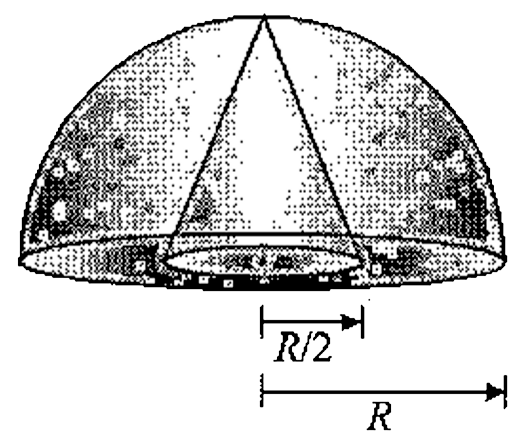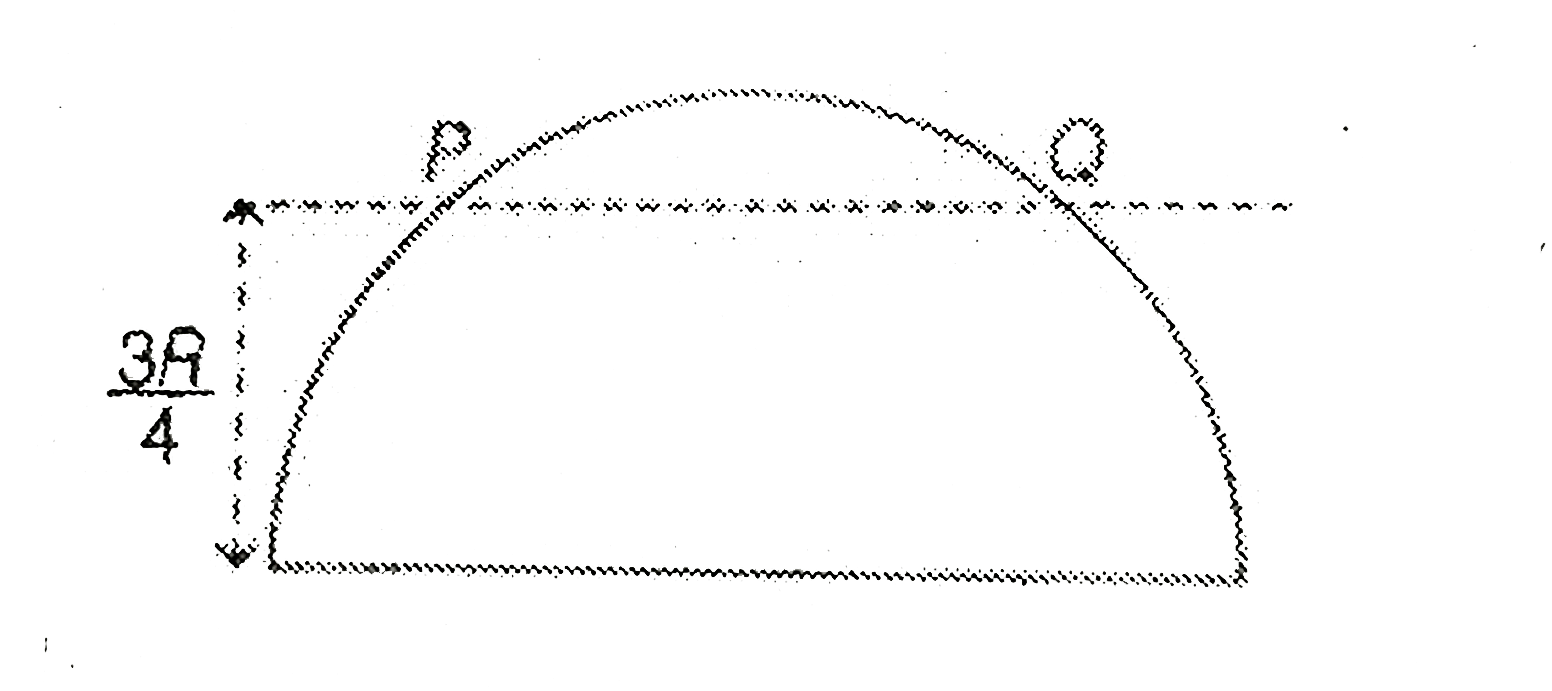A solid hemisphere of radius a and weight W is floating in liquid and at a point on the base at a distance c from the centre rests a weight w. The tangent of the inclination of the axis of the hemisphere to the vertical for the corresponding position of equilibrium is . [assuming the base of the hemisphere to be entirely out of the fluid]
43cawW
23cawW
83cawW
85cawW
The correct Answer is:C
To solve the problem of finding the tangent of the inclination of the axis of the hemisphere to the vertical when a weight w is placed at a distance c from the center of the base of a solid hemisphere floating in a liquid, we can follow these steps:
1. Understand the System:
- We have a solid hemisphere of radius a and weight W floating in a liquid. The base of the hemisphere is entirely out of the fluid. A weight w is placed at a distance c from the center of the base.
2. Identify the Center of Mass:
- The center of mass of the solid hemisphere is located at a distance of 3a8 from the flat base along the vertical axis.
3. Set Up the Torque Equation:
- For the system to be in equilibrium, the net torque about the point of contact (O) must be zero. The torques due to the weights W and w must balance each other.
- The torque due to the weight W (acting downwards at the center of mass) can be expressed as:
Torque due to W=W⋅(3a8sinθ)
- The torque due to the weight w (acting at a distance c from the center) can be expressed as:
Torque due to w=w⋅(csinθ)
4. Set the Torques Equal:
- Since the system is in equilibrium, we can set the two torques equal to each other:
W⋅(3a8sinθ)=w⋅(csinθ)
5. Simplify the Equation:
- We can cancel sinθ from both sides (assuming θ≠0):
W⋅3a8=w⋅c
6. Solve for tanθ:
- Rearranging the equation gives:
tanθ=83⋅c⋅wW⋅a
7. Final Result:
- Thus, the tangent of the inclination of the axis of the hemisphere to the vertical is given by:
tanθ=83⋅c⋅wW⋅a
- We have a solid hemisphere of radius a and weight W floating in a liquid. The base of the hemisphere is entirely out of the fluid. A weight w is placed at a distance c from the center of the base.
- The center of mass of the solid hemisphere is located at a distance of 3a8 from the flat base along the vertical axis.
- For the system to be in equilibrium, the net torque about the point of contact (O) must be zero. The torques due to the weights W and w must balance each other.
- The torque due to the weight W (acting downwards at the center of mass) can be expressed as:
Torque due to W=W⋅(3a8sinθ)
- The torque due to the weight w (acting at a distance c from the center) can be expressed as:
Torque due to w=w⋅(csinθ)
- Since the system is in equilibrium, we can set the two torques equal to each other:
W⋅(3a8sinθ)=w⋅(csinθ)
- We can cancel sinθ from both sides (assuming θ≠0):
W⋅3a8=w⋅c
- Rearranging the equation gives:
tanθ=83⋅c⋅wW⋅a
- Thus, the tangent of the inclination of the axis of the hemisphere to the vertical is given by:
tanθ=83⋅c⋅wW⋅a
Topper's Solved these Questions
- BOOK - DISHA PUBLICATIONCHAPTER - MECHANICAL PROPERTIES OF FLUIDS EXERCISE - EXERCISE-1 CONCEPT BUILDER59videos
MECHANICAL PROPERTIES OF FLUIDS
- BOOK - DISHA PUBLICATIONCHAPTER - MAGNETISM AND MATTEREXERCISE - EXERCISE-2:CONCEPT APPLICATOR31videos
MAGNETISM AND MATTER
- BOOK - DISHA PUBLICATIONCHAPTER - MOTION IN A PLANE EXERCISE - Exercise -2 : CONCEPT APPLICATOR28videos
MOTION IN A PLANE
Similar Questions
A hemisphere of radius R, made of glass of refractive index (3/2) is placed on 'the table. A point source of light is placed at a distance 2R from the centre, of hemisphere. If source is viewed diametrically opposite side of hemisphere. Find the position of image of source.
 View Solution
View SolutionFrom a hemisphere of radius R a cone of base radius R/w and height R is cut as shown in figure. Find the height of centre of mass of the remaining object.
 View Solution
View Solution
Knowledge Check
- Question 1 - Select One
A solid right circular cylinder is attached to a hemisphere of equal base. If the C.G. of the combined solid is at the centre of the base, then the ratio of the radius and height of the cylinder is
A1:2B√2:1C1:3DNone of these - Question 2 - Select One or More
A rod of weight w is supported by two parallel knife edges A and B and is in equilibrium in a horizontal position. The knives are at a distance d from each other. The centre of mass of the rod is at a distance x from A.
Athe normal reaction at A is wxdBthe normal reaction at A is w(d−x)dCthe normal reaction ar B is wxdDthe normal reaction at B is w(d−x)d. - Question 3 - Select One
A rod of weight W is supported by two parallel knife edges A and B and is in equilibrium in a horizontal position . The knives are at a distance d from each other . The centre of mass of the rod is at distance x from A . The normal reaction on A is
AW(d−x)xBW(d−x)dCWxdDWdx
A solid homigeneous hemisphere rests on a rough horizontal plane and against a smooth vertical wall. If the coefficient of friction is greater than 38, the hemisphere can rest in any position and if it is less, the least angle that the base of the hemisphere can make with the vertical is cos−1(8μ3). If the wall be rough, the coefficient of friction μ, this angle is cos−1(8μ3.1+μ'1+μμ') .
View SolutionA hemispherical portion of the surface of a solid glass sphere (mu = 1.5) of radius r is silvered to make the inner side reflecting. An object is placed on the axis of the hemisphere at a distance 3r from the centre of the sphere. The light from the object is refracted at the unsilvered part, then reflected from the silvered part and again refracted at the unsilvered part. Locate the final image formed.
View SolutionA ring of radius R has uniformly distributed charge. It spins about its axis with an angular velocity ω. P is a point on its axis at a distance x from its centre. The velocity of light in vecuum is c. The ratio of the magnetic field to the electric field at P is proportional to
View SolutionA solid glass hemisphere of density d and radius R lies (with curved surface of hemisphere below the flat surface) at the bottom of a tank filled with water of density ρ such that the flat surface of hemisphere is H depth below the liquid surface. Weight of water + tank is W1 and that of hemisphere is'W2. W Then choose the incorrect options
View SolutionThe radius of gyration of a solid hemisphere of mass M and radius Rn about an axis parallel to the diameter at a distance 34R is given by (centre of mass of the hemisphere lies at a height 3R/8 from the base.)
 View Solution
View Solution

